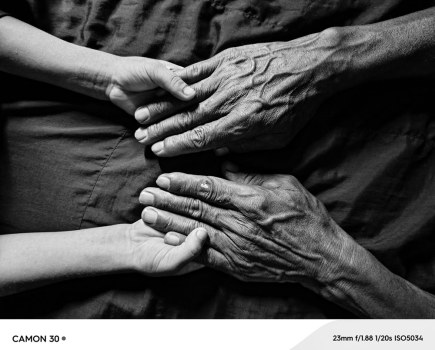A photograph of five whale sharks feeding together at night, in the waters off the Maldives, has won the Underwater Photographer of the Year (UPY) 2022 title for Rafael Fernandez Caballero from Spain.
Fernandez’s photograph, ‘Giants of the Night’, triumphed over 4,200 underwater pictures entered by underwater photographers from 71 different countries. The competition has been run since 1965 and in 2022 featured 13 international categories, plus four specific British categories. This year’s judges were the experienced underwater photographers Peter Rowlands, Tobias Friedrich and Dr. Alexander Mustard MBE.
The winning photograph captures a unique ocean event, taken in demanding photographic conditions, and it also won the Wide-Angle category of UPY 2022. It features five whale sharks, the biggest fish in the world, feeding together on nocturnal plankton that have been concentrated in the lights of a boat.
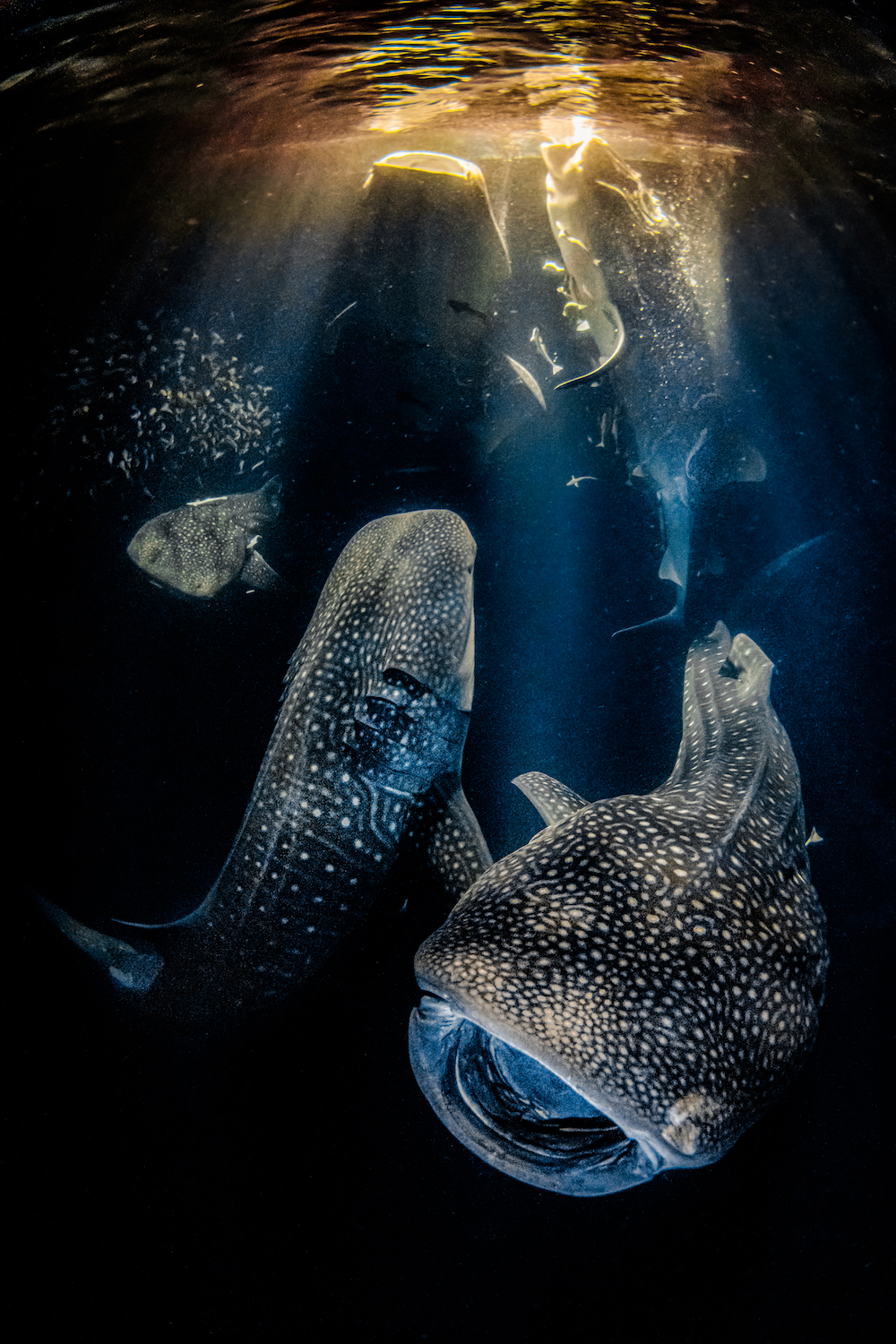
The winning image, of five feeding whale sharks off the Maldives, in the Underwater Photographer of the Year 2022 competition. Image: © Rafael Fernandez Caballero/UPY2022
Fernandez explained, ‘It was already incredible when one whale shark came to our boat. But more and more kept arriving. In the ocean magic can always happen. But when magic happens all together, you only can think you’re dreaming. This was the case of that night in Maldives.
At the beginning of the night one whale shark came to the light of our boat BlueForce One, we jumped in the water and then another whale shark came. We were so happy when, a couple of hours later, out of the blue, madness happened and whale sharks started to come in big numbers. I was together with Gador Muntaner, a shark researcher, who couldn’t believe what we were seeing. We counted, at the same time, 11 whale sharks surrounding us. It was a unique moment that no one there had thought it could even be possible. Magic happens in the ocean every day, but if we don’t protect the oceans and sharks, these moments will soon be a thing of the past.’
The image was shot in the Ari Atoll off the Maldives with a Nikon Z 7 II and an 8-15mm f/3.5-4.5E ED FISHEYE NIKKOR AF-S lens. The exposure was 1/80sec at f/4.2, ISO 5000. Lighting was with a One OrcaTorch D950V and the equipment was in Isotta Z7II/Z6II housing.
Competition judge, Peter Rowlands, commented, ‘this image took my breath away from the first viewing and I never tired coming back to it. Scale, light and the sheer numbers of big subjects, this was, by some distance, our winning image.’ Judge Alex Mustard added, ‘photography needs light and simply recording these giants in a dark ocean is a massive achievement. To do this with such beautiful light and careful composition of the five sharks is outstanding.’
See below for the stories behind all of the other winning images in the Underwater Photographer of the Year 2022 competition…
Behaviour & My Backyard categories
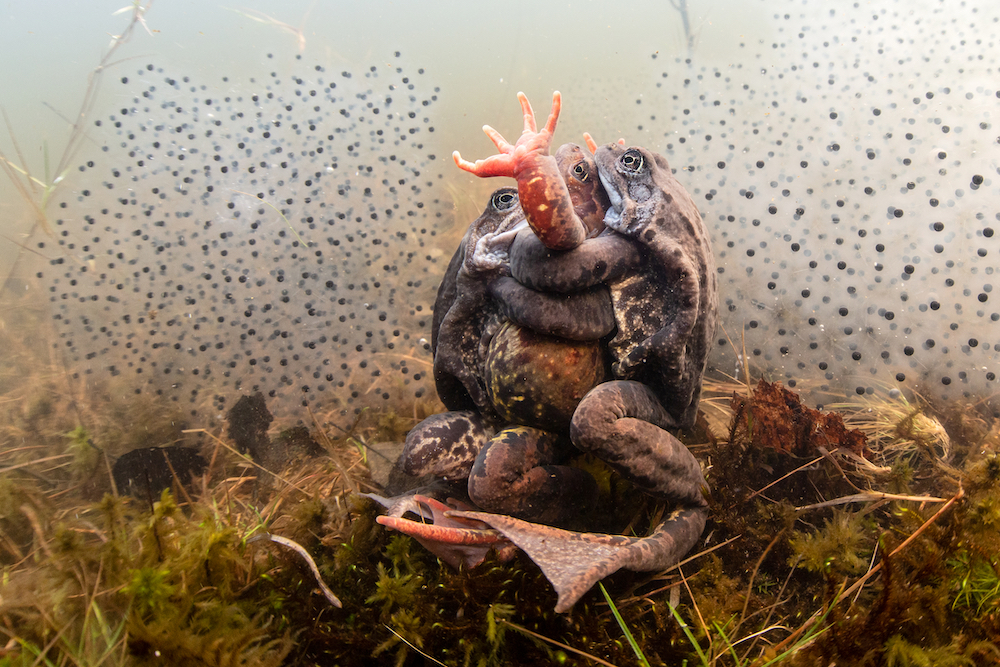
This image of spawning frogs, titled ‘All You Need Is Love’, won the Behaviour and My Backyard categories of the Underwater Photographer of the Year 2022 competition. Image: © Pekka Tuuri/UPY2022
Both the Behaviour and My Backyard categories of UPY 2022 were won by the same image. It was shot by Pekka Tuuri near the city of Vantaa in Finland. The image ‘All You Need Is Love’, was shot on a Canon EOS 5D Mark III (in Subal housing) with an EF8-15mm F/4 lens and a Kenko 1.4x teleconverter @15mm. The exposure was 1/30sec at f/11, ISO 640, in ambient light.
Tuuri explained, ‘All you need is love! This love pond is in my backyard, a 20 minute drive from home. And it has rewarded me plentifully over the past 10 years. It is full of love in late April. The common frogs come first, then toads and finally newts. I spent four days and four night time sessions in it in 2021. I wore a drysuit with argon, lots of undergarments and a heated vest to survive in the five degree water. I floated and stayed put among the frogs and quite soon they accepted me and my camera as a part of the scenery. The frogs climb on top of my camera, make grunting sounds in my ears and squeeze between my face and the backplate of the camera. The active spawning time lasts about two days and nights. What an experience with lots of photo ops!’
Up & Coming category

This image, titled ‘Supernova in Paradise’, won the Up & Coming category of the Underwater Photographer of the Year 2022 competition. Image: © Quico Abadal/UPY2022
Quico Abadal, from Spain, was named Up & Coming Underwater Photographer of the Year 2022 for his creative image ‘Supernova In Paradise’. Abadal’s photo was taken at sunset off Sairee Beach, Koh Tao, Thailand and is purposely shown upside down. The image was shot with an Olympus EM-1 Mark II with an 8mm PRO f/1.8 lens. The exposure was 1/160sec at f/5, ISO 200. The lighting was an Olympus UFL-3 unit and the camera was in an Olympus housing.
Abadal explained, ‘I first met Jeniya having breakfast at Zest, one of my favourite food spots of Koh Tao. We talked for long and we clicked quite well. A couple of days later we recorded a very cool video together. I knew I wanted to shoot more with her, she moved quite poetically underwater. So after a couple of months we met at the end of Sairee beach. She was wearing a stunning long white dress and we just planned to shoot mostly split shots with the sunset. I’d use the strobes to illuminate the underwater scene and the sun would do the rest. It was a pretty challenging shot, since I didn’t have any fins or wetsuit, so I would easily sink. Also it was tricky to gain focus properly on the subject. What I like about this photograph is the imperfection of backscatter, recreating space and making it perfect to me.’
‘Save Our Seas Foundation’: Marine Conservation Photographer of the Year 2022

This image, titled ‘Big Appetite’, won the Marine Conservation category of the Underwater Photographer of the Year 2022 competition. Image: © Thien Nguyen Ngoc/UPY2022
Thien Nguyen Ngoc, from Vietnam was named ‘Save Our Seas Foundation’ Marine Conservation Photographer of the Year 2022 for his aerial drone image of anchovy fishing shot off the coast of Hon Yen, Phu Yen province, Vietnam. The image was shot with a Hasselblad DJI Mavic Pro 2 and a 28mm f/2.8 lens. The exposure was 1/60sec at f/2.8, ISO 100.
Ngoc explained, ‘Many local fisherman families along the coastline will follow the near-shore currents to catch the anchovy during peak season. Salted anchovy is the most important raw material to create traditional Vietnamese fish sauce, but anchovies are a little fish with a big impact. When they are overfished, the whales, tuna, sea birds… and other marine predators that rely on them as a dietary staple face starvation and population… decline critically. And so far Vietnam is also facing this anchovy overfishing situation. According to the survey results of the Institute of Seafood Research, the reserves and catches of anchovies in the waters of Vietnam have decreased by 20-30% in the past 10 years.’
Wrecks category
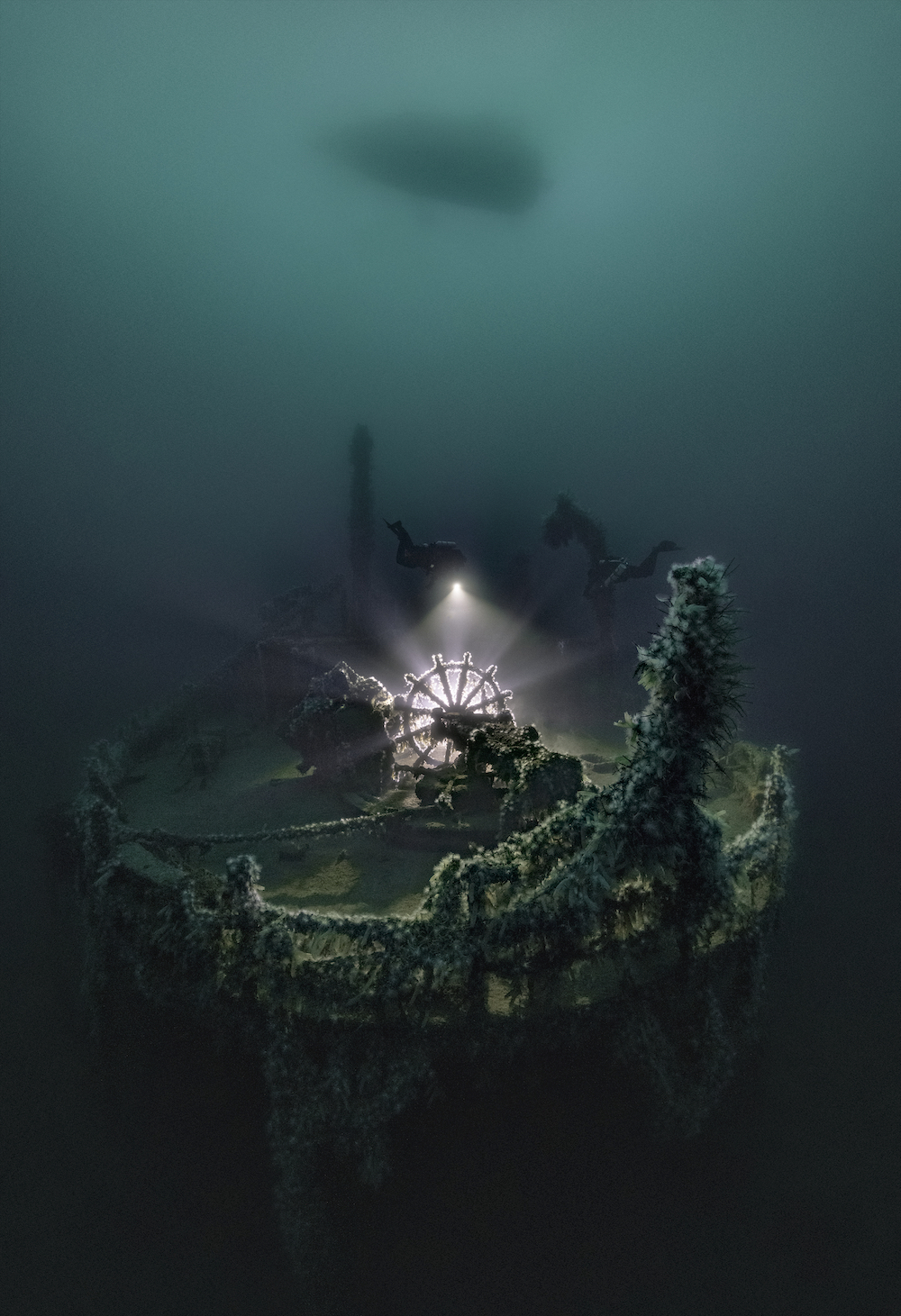
This image, of the wreck of the Tyrifjord in Norway, won the Wrecks category of the Underwater Photographer of the Year 2022 competition. Image: © Alex Dawson/UPY2022
Alex Dawson won the Wrecks category of UPY 2022 with an image of the wreck of the Tyrifjord that was shot 40 metres underwater. The photograph was shot with a Nikon D850 (in a Sea&Sea MDX-D850 housing) with a Nikkor 8-15mm fisheye lens. The exposure was 1/50sec at f/4.5, ISO 500. It was lit with a Bigblue light.
Dawson revealed, ‘The wreck of Tyrifjord is one of the favorite wrecks in the Gulen dive resort area of Norway. She sits in approximately 40 metres and is very sheltered from most winds. This is one of the dives we always try to do on our wreck safari that we try to do almost every year. We are a mixed group of Norwegians, Swedish, Danish and Dutch that usually meet up. The highlight of the wreck is always the huge extra steering wheel in the aft. You can see the 50+ foot dive boat up on the surface from 40 metres depth at the top.’
Macro category

This image of a green prawn and a pipefish frogs, titled ‘Mimicry’, won the Macro category of the Underwater Photographer of the Year 2022 competition. Image: © Javier Murcia/UPY2022
Javier Murcia won the Macro category with his shot taken in seagrass meadows at La Azohia, Cartagena, Spain. The picture was shot on a Nikon D850 (in Isotta housing) with an AF Micro-NIKKOR 60mm f/2.8D Lens. The exposure was 1/250sec at f/8, ISO 200, and Inon z330 lighting was used.
Murcia revealed, ‘This image is the result of many hours working with the species that live in the seagrass meadows. Both species, both the pipefish (Syngnathus abaster) and the green prawn (Hippolyte sp.) live on the leaves of seagrasses. It is not the first time that I have seen this curious behaviour; I have been able to observe it on four or five occasions but I had never been able to take a good photo of it (after many hours and days looking for the moment). Sometimes the shrimp would move and other times the pipefish would quickly hide in my presence. The pipefish looks like a seagrass leaf and for this reason some prawns merge with its body thinking that they are leaves that move. Both are mimetic species.’
Compact category
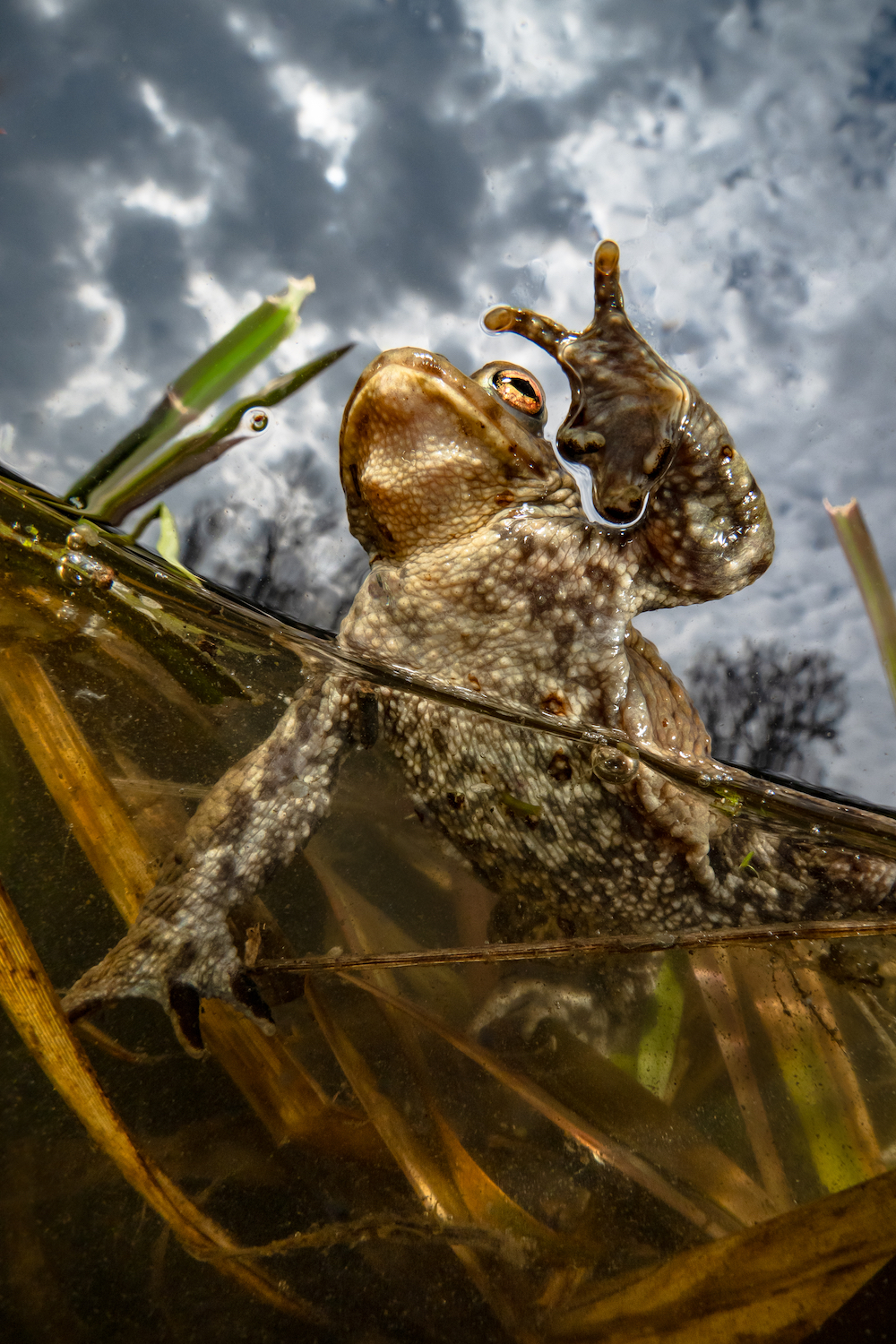
This image of a toad, titled ‘Peace’, won the Compact category of the Underwater Photographer of the Year 2022 competition. Image: © Enrico Somogyi/UPY2022
Enrico Somogyi won the Compact category with his image shot in a pond at Leipzig, Germany. The photograph was shot with a Sony RX100v II (in a Fantasea housing) with a Fantasea UWL-09 lens. The exposure was 1/2000sec at f/8, ISO 160. It was lit with three Backscatter Miniflashes.
Somogyi explained, ‘Once a year at the end of March it is mating time for the toads. It lasts only few days and only at this time is it possible to get very close to them. Normally they are very shy. I was trying to get a split shot with this toad, when he started to crawl on my small domeport. I got some pictures from this action and this was my favourite pic.’
Portrait category
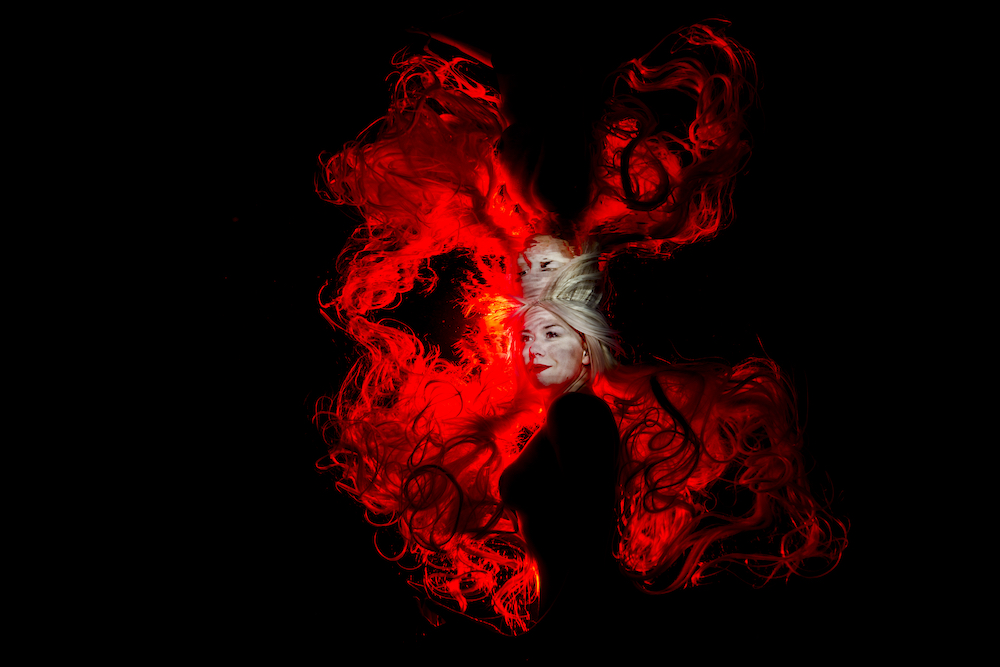
This image, titled ‘Rapunzel On Fire’, won the Portrait category of the Underwater Photographer of the Year 2022 competition. Image: © Thomas Heckmann/UPY2022
Thomas Heckmann won the Portrait category of UPY 2022 with his imaginative shot taken in his underwater studio in Germany. It was shot on a NikonD800E (in Seacam housing) with a Nikkor 16-35mm zoom lens @ 20mm. The exposure was 1/200sec at f/13, ISO 100. The lighting used was Subtronic Mega, Nova, pro160, Fusion, and a Retra Snoot.
Heckmann revealed, ‘Our image idea was to create a completely black silhouette in the foreground, but at the same time make eye contact with the viewer. To make the hair glow, the camera settings were for the silhouette and three powerful strobes were needed, hidden in the background. These background strobes were triggered by long cables and an additional RSU. For the face I used a combination of video light/strobe (Subtronic Fusion) with a Retra LSD snoot for the front.’
Black & White category
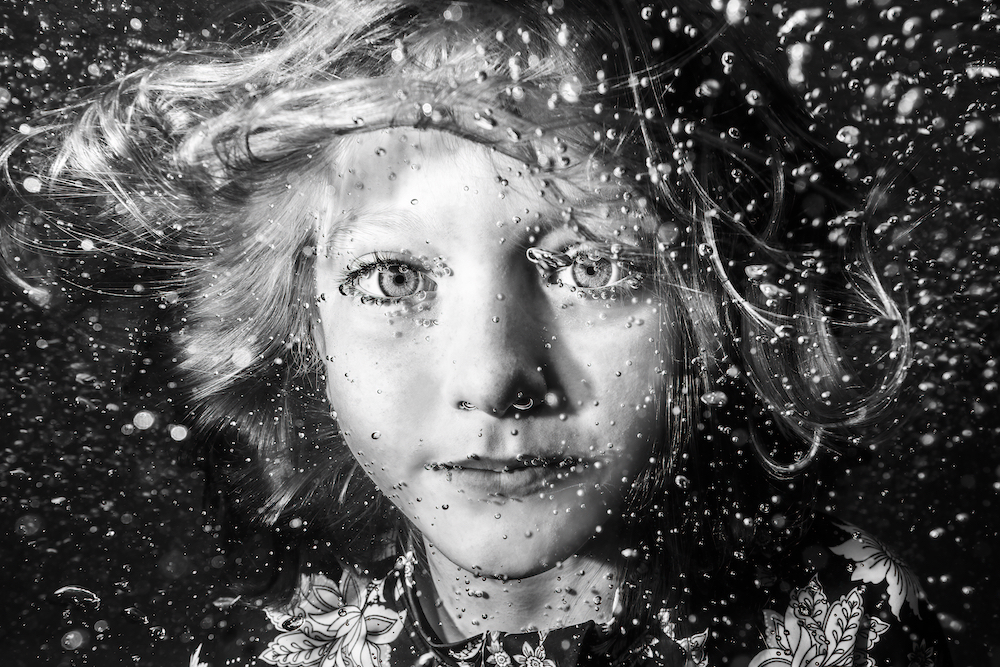
This image, titled ‘Sarah’s Underwater World’, won the Black & White category of the Underwater Photographer of the Year 2022 competition. Image: © Kerrie Burow/UPY2022
Kerrie Burow won the Black & White category of UPY 2022 with an image of her niece Sarah, shot in central Queensland, Australia. The picture was shot on a Canon EOS 5D Mark IV (in Isotta housing) with an EF 16-35mm f/2.8L II USM zoom lens. The exposure was 1/250sec at f/9, ISO 200. The lighting used was Inon Z-330.
Burow explained, ‘This shot was taken a year into the Coronavirus pandemic; my 7-year-old niece Sarah stares with wonder into my housing dome while on one breath underwater. The scene portrays the therapeutic power of water, which so many of us experienced during the pandemic. The underwater world offered peace, comfort and hope – for the anxious, the depressed and the grieving. It gave us a chance to feel joy and adventure again as well as freedom from the heavy weight of the pandemic – even if just for a moment while on one breath. The portrait was taken using an unobtrusive photojournalist technique. I minimalised my presence, gave no instructions to Sarah and, instead, allowed the scene to evolve naturally.’
British Underwater Photographer of the Year
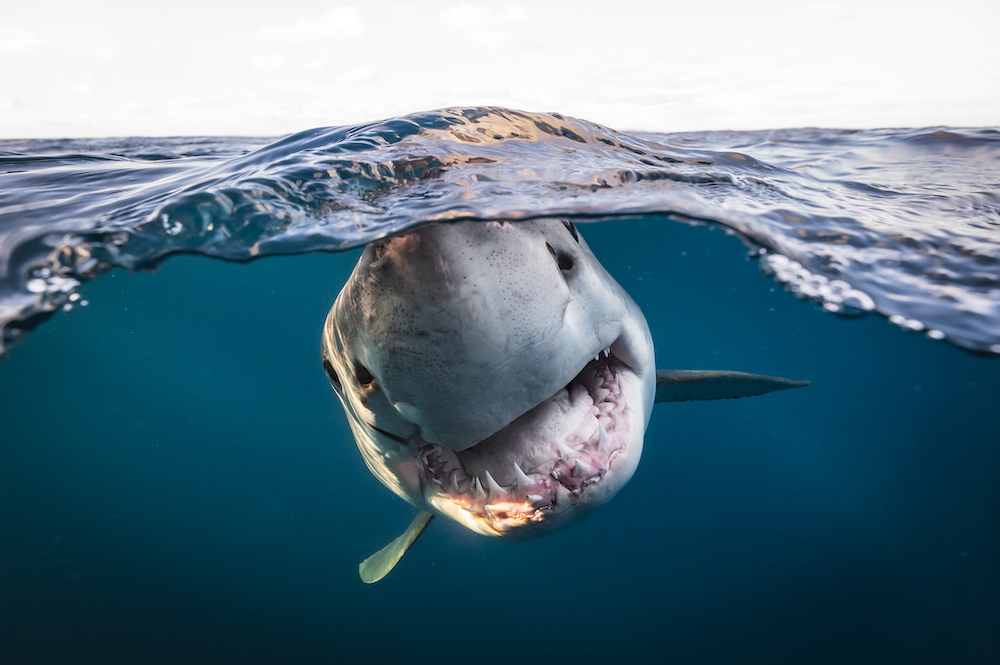
This image, titled ‘Great White split’, won the British Underwater Photographer of the Year category of UPY 2022. Image: © Matty Smith/UPY2022
Matty Smith was crowned British Underwater Photographer of the Year 2022 with an image of a Great White shark that he shot at the North Neptune Islands off Australia. The picture was shot in natural lighting with a Nikon Z 6 II (in Aquatica housing) with a Nikkor 14-24mm F2.8 S Series lens. The exposure was 1/1000sec at f/8, ISo 2800.
Smith revealed, ‘I had wanted to shoot a charismatic over/under [water] portrait of a great white shark for a couple of years. Some techniques I had previously tried failed terribly, so this time I designed and constructed my own carbon pole and remote trigger. This enabled me to safely lower my camera and housing into the water with my own 12” split shot dome port attached. Surprisingly the sharks were instantly attracted to the camera with no extra bait needed, in fact it was a battle to stop them biting the dome port! We had wonderfully calm seas and nice evening side lighting for this naturally lit image.’
Most Promising British Underwater Photographer of the Year
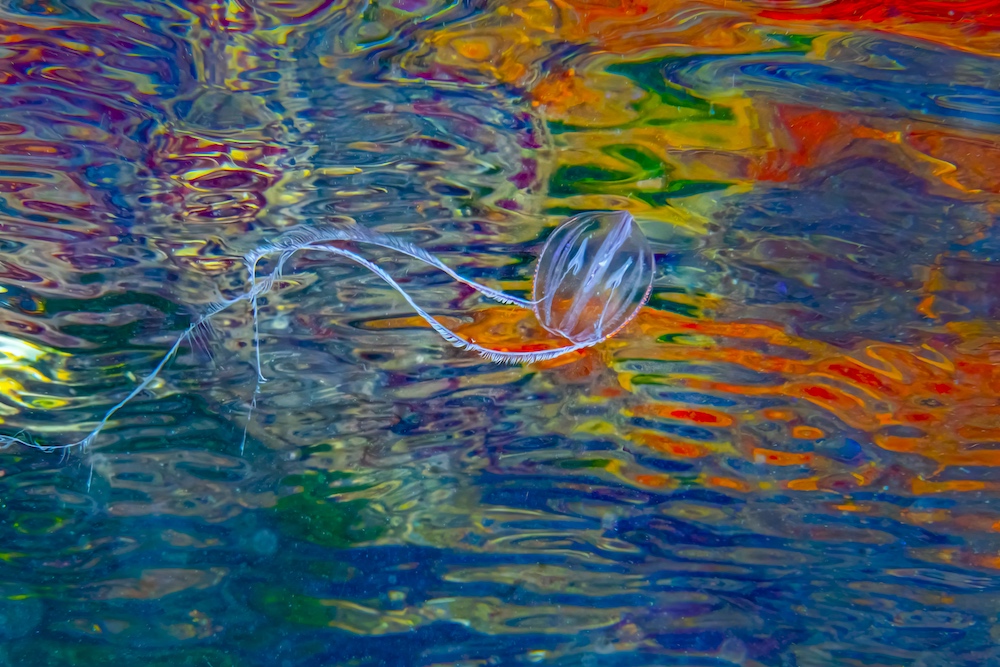
This image, titled ‘Diamonds and Rust’, won the Most Promising British Underwater Photographer of the Year category of UPY 2022. Image: © Paul Pettitt/UPY2022
Paul Pettitt won the Most Promising British Underwater Photographer of the Year 2022 with an image of a sea gooseberry off Swanage Pier in Dorset, England. It was shot with a Nikon D500 (in a Nauticam housing) and a 60mm lens. The exposure was 1/200sec at f/22, ISO 250, with one inon 240 light used.
Pettitt revealed, ‘This picture was taken on a bright afternoon when I knew the sun would be on the west side of the Pier. The Sea Gooseberries had been around for a while and on this particular day the water was like glass. I floated in the spot I wanted and waited for them to slowly drift by. The background colours represent the rust and weed growth on a metal cross beam.’
British Waters: Wide-Angle category

This image, titled ‘Gannet Storm’, won the British Waters: Wide-Angle category of UPY 2022. Image: © Henley Spiers/UPY2022
Henley Spiers won the British Waters: Wide-Angle category with his image ‘Gannet Storm’, shot off the Shetland Islands in Scotland. It was shot with a Nikon D850 (in Nauticam D850 housing) and a Nikkor 28-70mm @ 35mm with a Nauticam WACP-1 port. The exposure was a1.8sec at f/22, ISO 125. The scene was lit with two Inon Z240s.
Spiers revealed, ‘A northern gannet swims in an artistic hail of bubbles created by diving seabirds. 40,000 gannets visit the nearby cliffs annually to lay and care for a single egg, fishing for food nearby. Hitting the frigid water faster than an Olympic diver, these incredible birds have evolved airsacs in the head and chest to survive these repeated heavy impacts. From underwater, the sound was thunderous as streamlined, white torpedos pierced the surface. I wanted to create a novel image of these handsome seabirds and resolved to try and capture their movement through a slow exposure. The speed of the gannets led to innumerable failures but in this frame we retain strong eye contact with the gannet, even as the scene is artistically softened. With great thanks to Richard Shucksmith, without whom this encounter with the gannets would not have been possible.’
British Waters: Macro category
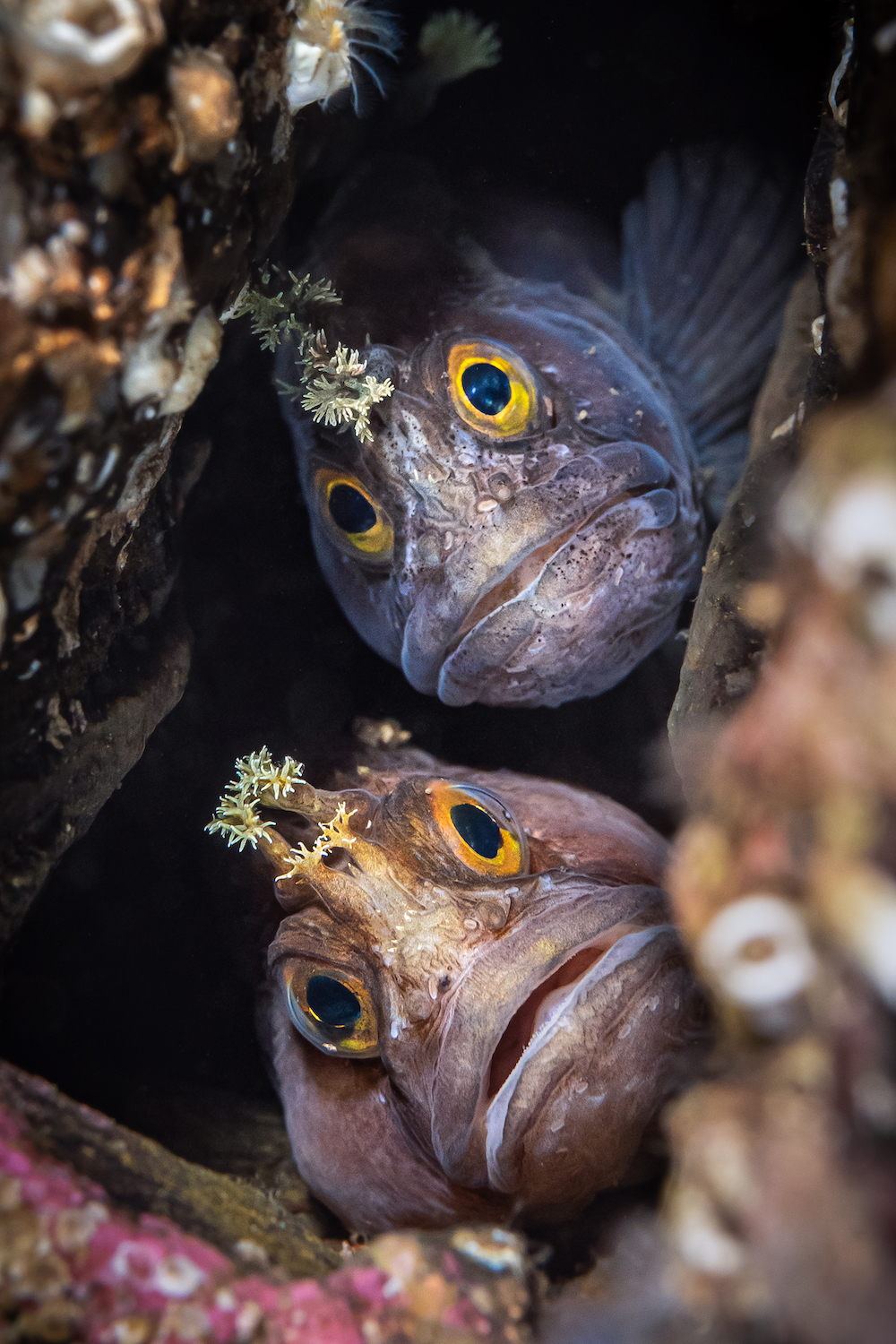
This image, titled ‘Best Buddies’, won the British Waters: Macro category of UPY 2022. Image: © Dan Bolt/UPY2022
Dan Bolt took the British Waters: Macro category with his comedic image ‘Best Buddies’, shot in Loch Carron, Scotland. The picture was shot on an Olympus OM-D E-M1 (in Aquatica A-EM1 housing) with an Olympus 60mm macro lens. The exposure was 1/250sec at f/8, ISO 500. It was lit with two Sea & Sea YS-D1 lights.
Bolt explained, ‘2021 was the 10 year anniversary of my first trip to the beautiful Loch Carron and, in all that time, it has never failed to produce stunning underwater images with its diverse array of marine inhabitants. My buddies know that I’m not very good at finding Yarrels blennies, and it was no exception on this dive either. We were diving on an area of reef I’d not previously explored, and after an excited squeal and waving of a torch in my direction I dropped down to see that my buddy had found not one, but two beautiful little blennies holed up in a crack in the rock. Having my long macro lens on was an advantage as I could stand-off from the reef enough to get some light into their home so we could all see their some-what bemused little faces. Best buddies for sure!’
British Waters: Living Together category
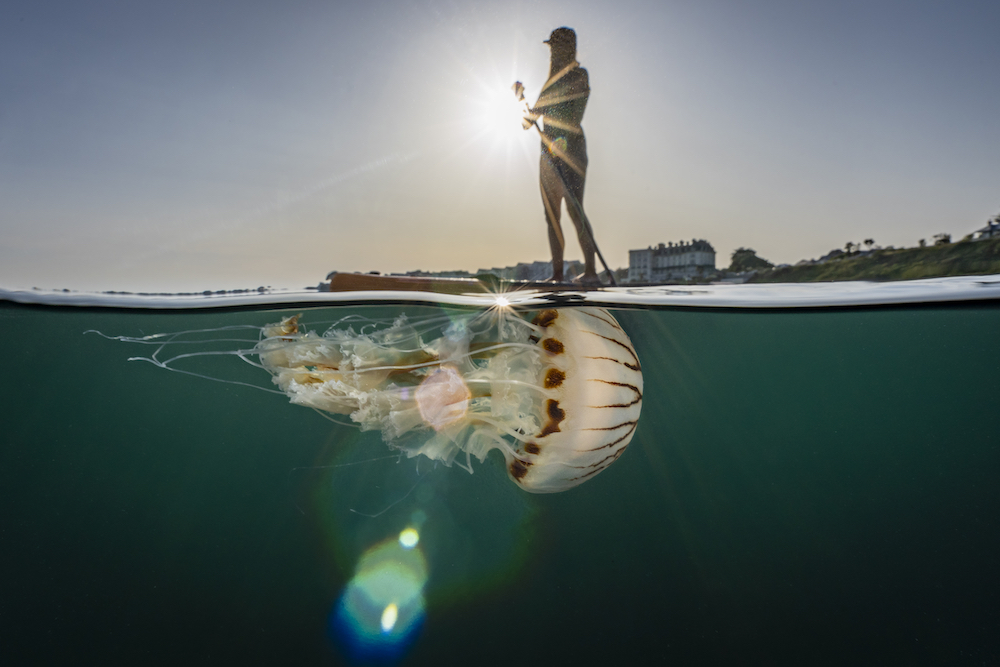
This image, titled ‘A Peaceful Co-existence’, won the British Waters: Living Together category of UPY 2022. Image: © Lewis Jefferies/UPY2022
Lewis Jefferies won the British Waters: Living Together category with an image shot off Falmouth in Cornwall, England. The photograph was taken with a Sony A7 III (in Nauticam housing) and a
Sony 16-35mm zoom lens. The exposure was 1/250sec at f/22, ISO 320. It was lit by two Inon Z240 lights.
Jefferies explained, ‘In the summer months jellyfish frequent the British Isles in larger numbers, thought to be attracted by the warmer waters. The summer of 2021 was no exception and there were huge numbers of these Compass jellyfish in Falmouth Bay. It was a perfect summers evening – clear and calm with hardly a breath of wind. We grabbed the paddle board and camera and headed to the beach in search of jellyfish. I had a sunset shot like this – loosely – in mind and fortunately all the elements lined up to create something quite memorable. I hope my image can inspire others to explore and appreciate the wonders that are found right in our backyard, in British waters.’
British Waters: Compact category

This image, titled ‘Rock pool star’, won the British Waters: Compact category of UPY 2022. Image: © Martin Stevens/UPY2022
Martin Stevens took the British Waters: Compact category with an image of a starfish shot in Falmouth, Cornwall, England. It was shot in natural light with a Canon G9X Mark II (in Fantasea FG9X housing) and a Weefine WFL-02 Fisheye lens. The exposure was 1/60sec at f/11, ISO 160.
Stevens explained, ‘Living from shallow down to deep water and reaching impressive sizes, spiny starfish are abundant in Cornwall. I’ve often taken photos of them underwater, but on a low tide they can be found in the exposed rock pools. Last year we had very low spring tides, and I wanted to attempt some split shots of a starfish in the pools. So, I attached a fisheye wet lens and was lucky with bright conditions, and after a while came across a large starfish in a gully flanked by exposed kelp. The water was clear and calm, and given that starfish aren’t the quickest of creatures I could compose some photos with the gully and kelp behind and a little of the starfish showing through the water from above. At the same time, seaweed is most vibrant in the spring, which added a splash of red colour to the scene.’
About Underwater Photographer of the Year
Underwater Photographer of the Year is an annual competition, based in the UK, that celebrates photography beneath the surface of the ocean, lakes, rivers and even swimming pools. British photographer Phil Smith was the first Underwater Photographer of the Year in 1965. Today’s competition attracts entries from all around the world. To discover more visit the Underwater Photographer of the Year website.
Related articles:
Essential guide to underwater photography
Best photography exhibitions to see in 2022






